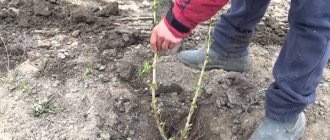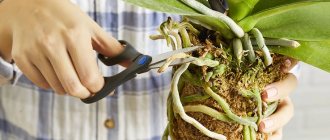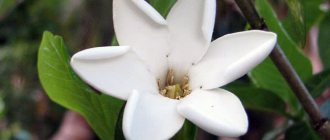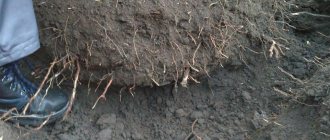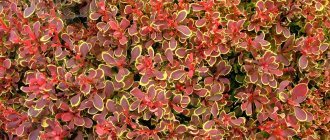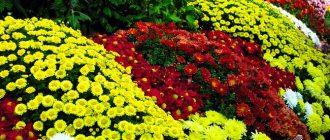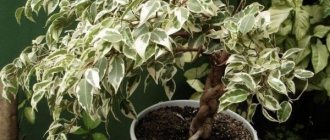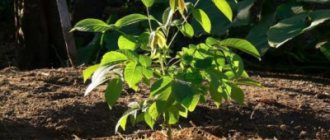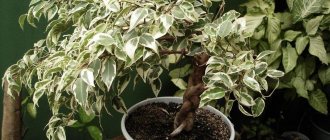- September 22, 2019
- Houseplants
- Maria Vetoshkina
Flower growers love to grow bamboo, because it is easy to care for and you can create a variety of unique compositions from it. At the same time, bamboo is planted differently, and each method has its own advantages. That is why information on how to replant bamboo at home will be of interest to many.
Transfer rules
Bamboo shoots are best germinated in water. They should be transplanted into the ground when the roots reach 4-5 cm. Bamboo cuttings with small roots do not take root well, and roots that are too long are easy to damage during planting. It is necessary to remove the cuttings from the water before planting.
You can use any rooting agent; you just need to sprinkle it on the damp roots. A pot of soil must be prepared in advance; a hole in the soil must be made slightly larger than the rhizome.
The soil should be added in small portions until the pot is filled. The soil should not be compacted too much to avoid damaging the young roots.
After planting, the cuttings are watered and, if necessary, soil is added. In order for the young shoot to take root better, it can be sprayed with water in the first week.
Propagation of indoor bamboo
There are 2 ways to propagate bamboo:
- By cuttings.
- Root division (rarely used).
When transplanting an adult plant, large shoots are separated and immediately planted in the soil in a separate pot. At first, the shoot should be watered abundantly or rooted immediately in water. A lot of sunlight is contraindicated for young plants.
Sometimes you can find bamboo seeds on sale; there is no need to purchase them. It will be a waste of both time and money. Growing Dracaena Sander from seeds is almost impossible.
Bamboo Fertilizer
Plant nutrition should be rich in minerals and organic substances . It is best to purchase a special fertilizer for dracaenas in the store, which will contain just a lot of the components necessary for the nutrition and development of the plant. In autumn and winter, fertilizing should be done 1-2 times. In warm weather, at least once every 3 weeks. If indoor bamboo begins to grow very slowly, this should be regarded as a call to fertilize the soil.
Selecting a site and preparing for transplantation
Before transplanting, you need to prepare everything you need. To do this you will need: a planting container, soil, drainage material, and a means for rooting the flower.
The choice of location also needs to be approached carefully. Bamboo came to us from tropical forests, where the climate is humid and warm. Therefore, a bamboo indoor plant will do well in a warm and well-lit corner. He only needs diffused light; light partial shade is also suitable. The most comfortable temperature is considered to be from 20 to 25 degrees. In the room where bamboo grows, the air should not stagnate.
Where to put it, growing conditions
When growing, it is recommended to choose a place for it in advance. This can be on the east or west side of the house; the flower should be protected from sunlight. In accordance with the requirements of Feng Shui, the optimal place for bamboo is considered to be the southeast direction.
It is important to consider that a lack of light can lead to a decrease in the activity of flower development; it will lose leaves and look bad. Temperature also plays an important role; the best temperature is considered to be 18-25 degrees. The houseplant can tolerate hot weather well; it feels great in thirty-degree heat.
Bamboo grown in water is distinguished by its harmonious development; its height can reach 80-200 cm. This plant is very easy to grow in a group; the stems tied with ribbon look great in any interior.
Soil and pot for the plant
In what soil should I plant bamboo? This plant belongs to the dracaena family, so for planting it, a ready-made soil mixture specially designed for dracaenas is best suited. It can be purchased at a specialty store.
The container for planting bamboo can be anything, the main thing is that it must meet two requirements:
- The diameter of the pot should be approximately twice the size of the plant's rhizome.
- The pot must have drainage holes.
The plant will look very impressive in a beautiful vase if its stems are additionally tied with a bright ribbon.
How to properly care for a plant
Growing bamboo at home is not easy, despite its love of moisture and rapid growth in favorable conditions. Creating such an environment will require constant attention, the availability of prepared water, and certain skills in floriculture. A unique green perennial will be an excellent decoration for a house or apartment if you provide it with suitable growth conditions - choose the right location, moisten it in a timely manner, prune it, protect it from pests and diseases, and properly care for it.
Watering
It is necessary to moisten the soil only with warm rain, settled water. Regular tap water contains many impurities harmful to plants, which accumulate in the roots and slow down natural processes - photosynthesis worsens, leaves turn pale and become deformed. At such moments, the plant is susceptible to attacks by parasites and loses immunity to many diseases. If it is not possible to collect or filter the liquid, you can soften it by freezing. Water is poured into a plastic bottle and placed in the freezer. After thawing, it becomes suitable for watering.
The frequency of watering bamboo palms depends on the time of year. In spring and summer, moisture should be plentiful, in autumn and winter - moderate. With the arrival of cold weather, the plant can be transferred to independent control of its moisture needs by transplanting it into a vase with water.
It is recommended to water bamboo through a tray. The roots of the plant absorb liquid according to their needs. After a few hours, the water is poured out of the pan. The procedure is repeated when the top layer of soil is completely dry. Do not use a spray bottle or water at the root. Such methods of moistening can lead to the formation of rot on the roots.
Watering should be stopped if the soil begins to emit a putrid odor. If the top layer of soil is covered with a gray or white coating, it must be replaced, the bamboo roots must be washed and disinfected.
Fertilizer
The young sprout does not need additional nutrition, because the soil is still rich in microelements. But as bamboo grows, it actively pulls them out, depleting the soil. Therefore, it is necessary to feed dracaena with both mineral and organic fertilizers. It is best to purchase special preparations that are designed for dracaena. They are ideal for bamboo. During the autumn and winter seasons, one dose of nutrients is sufficient. But during the warm season this needs to be done monthly.
How to trim bamboo at home
There are several methods for propagating bamboo:
The method of propagation by seeds at home is almost impossible. This is due to the difficult process of growing seeds and caring for seedlings.
The most suitable method of propagation at home is cuttings:
- Spring is the best time of year for this process. During this period, shoots appear on the flower, which are used for planting;
- For planting it is necessary to use special soil;
- A large pot is the most suitable container for planting bamboo. Despite their small size, the shoots and their root system grow very quickly.
You should also replant the main plant once every 2-3 years. In addition to watering, you need to constantly loosen the soil in the pot to better enrich the roots of the flower with oxygen.
How to replant bamboo in an apartment
Bamboo is an unpretentious plant; it grows well in water, in soil, and in hydrogel. But he will feel best in the ground.
The process of planting bamboo in a pot is as follows:
- For planting, you need to choose healthy, richly green seedlings that have living, undamaged roots.
- It is better to choose a pot deep enough and spacious enough so that the roots have room to grow. Particular attention should be paid to the drainage holes to ensure the outflow of water from the container.
- The soil, as mentioned above, must be taken ready-made. Expanded clay or small pebbles are suitable for drainage.
- Water for irrigation should be melted or settled.
The drainage layer should be at least 3 cm; moistened soil is placed on it in small portions and a hole is immediately made. The cuttings are taken out of the water, a preparation for root growth should be sprinkled on the roots and a little of this preparation should be added to the hole itself.
The roots are sprinkled with earth, compacted a little, and the pot is completely filled with soil. Water thoroughly so that water flows out through the drainage holes. Water must be removed from the pan so that it does not stagnate.
Secrets of replanting bamboo. Detailed description of the process
Many lovers of indoor plants gravitate towards exotic specimens. An exotic that does not require special care, a real find. Such a pet could be the Good Luck plant or Lucky bamboo - an evergreen perennial Dracaena Sandera, one of the species of the Dracaena genus. It is very decorative, especially shaped in the form of figurines.
Lucky bamboo can grow in water, hydrogel and soil. However, it will only be truly happy when it grows in the ground. When transplanting a lucky one from water to land at home, adhere to the following rules:
- A healthy seedling is selected, rich green in color with living, undamaged roots.
- The vessel for planting is selected for growth, deep and wide enough so that the roots are not crowded. Particular attention is paid to drainage holes. They ensure good drainage of water from the vessel.
- It is better to take ready-made soil for dracaenas. Expanded clay or small pebbles are used for drainage.
- Prepare water in advance, preferably melt water.
After everything is prepared, the transplantation begins. Drainage is poured into the pot, in a layer of 2-3 cm. Then moistened soil is added, in which a spacious hole is formed. The seedling is carefully removed from the water, the roots are sprinkled with a preparation for root growth, and it is added to the hole. The plant is lowered into the hole, ensuring the integrity of the roots, and the stem is leveled.
Carefully fill the hole with earth, filling it up to the top edge of the bowl and lightly compacting it. Water generously so that the water flows into the pan. Stagnation of water should not be allowed, so the water is poured out of the pan. During the first week, the planted plant is sprayed daily with water from a spray bottle. As needed, soil can be added to the pot.
Bamboo, whose height reaches 11 meters, is distinguished by strong branching in its upper part. Bamboo is characterized by rapid growth, up to 0.7 m in height per day and is the fastest growing plant in the world. Spikelets are multi-flowered, arranged in groups and singly on branches with scale-like leaves.
The flowers of the plant are bisexual and wind-pollinated. Ripe grains fall out of the scales and are spread by wind or animals. The above-ground part, after completing its fruiting, completely dies, leaving only the rhizome in a viable state. On average, bamboo in a country house lives for several decades. The duration of the life cycle directly depends on the growing conditions.
Many lovers of indoor plants gravitate towards exotic specimens. An exotic that does not require special care, a real find.
Such a pet could be the Good Luck plant or Lucky bamboo - an evergreen perennial Dracaena Sandera, one of the species of the Dracaena genus. It is very decorative, especially shaped in the form of figurines.
It is unpretentious and can be grown in water and a pot with hydrogel or soil. But it is more natural for it to grow in the ground. Therefore, information on how to replant bamboo will be useful to many gardeners.
Possible problems
The above describes in detail how to replant bamboo, but after replanting the following problems may arise:
- The tips of the leaves dry out. Dry air or lack of heat is to blame for this.
- The leaves begin to turn yellow. If the leaves turn yellow slowly and infrequently, then this can be considered a natural process. If the leaves turn yellow constantly, this indicates a lack of nutrition; the plant needs to be fed.
- The leaves are curling up. This may be due to low temperature.
- Spots appear on the leaves: yellow-brown or dry. They can be caused by direct sunlight.
Watering
Dracaena Sandera loves the golden mean - ideally the soil should be slightly moist. Too much and too little water is bad. In practice this looks like a good full watering once a week if the plant is in a pot with soil.
When kept in water, it is necessary to periodically change the water, using only water that has stood for one day. It is advisable to do this at least once every two weeks to avoid a putrid smell.
You can add a little fertilizer to the new water, but do this with caution, since an overdose will have an adverse effect on the plant - it will quickly draw the necessary substances from the water.
The plant perceives warm “rain” very well; it is enough to carry out this procedure once a month, the water should be slightly warm. It is important to ensure that water after such watering does not accumulate in the space between the leaves, which can lead to rotting of the plant. The described watering regime is good for winter; in summer, the frequency of watering is doubled, and on particularly hot days, watering is done every other day. Additional humidification of the air around the plant is not required.
Standard indoor humidity conditions - 30–60% are quite suitable for successfully growing dracaena
Lighting, humidity and temperature
Proper lighting is important for any plant. Bamboo, like other dracaenas, loves bright rooms, but direct sunlight will not benefit the plant. Direct sun may cause burns on the leaves. The flower will feel good in diffused sunlight. It will grow in partial shade, but insufficient lighting inhibits growth, and in this case the leaves may turn pale.
Bamboo is a tropical plant, so dry air is unacceptable for it. To humidify the air around the plant, you can place containers of water nearby, or use a special humidifier. The flower will also appreciate daily spraying.
Homemade bamboo loves warmth very much. In an ordinary apartment he will be quite comfortable, you just need to make sure that the air temperature does not drop below 20 degrees. The room where the plant is located can, and even should, be ventilated, but bamboo does not like drafts.
Thus, if you follow the conditions of keeping the plant, then planting bamboo, as described above, will not be difficult, because the plant will be healthy and strong.
Further care
Knowing how to properly care for home bamboo, you can grow a delightful plant - the pride of every gardener. Such care includes periodic watering, proper fertilizing, properly selected lighting, comfortable temperature, and appropriate humidity.
Watering
In the hot season, dracaena is watered as the top layer of soil dries. Foliage spraying can be done daily. During the cold period, wait until the soil in the container is half dry. Stagnation of water should not be allowed. There are special requirements for water quality. It should be clean, soft, filtered and at room temperature. It is recommended to use melt water.
Top dressing
Bamboo transplanted from water to ground begins to be fed after three weeks, when it has taken root well. Then the fertilizer is applied once a month from the beginning of spring until mid-autumn. Fertilizers should contain more nitrogen and phosphorus.
Lighting
Light for any plants plays a decisive role in their development. Dracaena needs a bright room, but without direct sunlight. Strong, direct sun can burn the leaves. The most optimal conditions are diffused sunlight. Home bamboo is not afraid of partial shade, but a lack of light leads to growth retardation and loss of color.
Plant pests and diseases
A healthy flower is practically not affected by diseases and pests. The latter include spider mites and mealybugs.
The first entangles the leaves with a cobweb. Spraying with Aktara helps combat it.
Mealybug appears as white lumps in the leaf axils. These lumps need to be removed and then treated with the Actellik insecticide.
The following diseases can be noted:
- Dark spots on the leaves are a fungal disease. It is necessary to treat the plant with a fungicide and ventilate the room more often.
- Slow growth - the plant lacks minerals. You need to feed it with a complex product.
- The leaves become dark and soft - the temperature in the room is too low, it needs to be increased.
Disease Prevention
- The appearance of dark spots on the leaves indicates a fungal disease. The room should be well ventilated and the bamboo should be treated with a fungicide.
- Bamboo does not grow - lack of minerals. Feed and increase the dose of nutrients.
- The leaves darken and become soft - the plant is cold. Raise the temperature to a comfortable level.
Simple rules of care will allow you to avoid problems when growing happy bamboo and will prolong its life.
Indoor bamboo (Dracaena sandera) is a unique cereal plant that does not fit one type. Flower growers like it because it has an unusual stem-trunk; it can be processed and shaped as only imagination allows.
Bamboo is an ordinary, very tall plant, but the decorative version is about half a meter. Attention! Bamboo is a heat-loving grass; it feels favorable in summer at 23-30 degrees, in winter - not lower than 16 degrees.
In the photo below you can see what composition can be created from bamboo with proper care:
